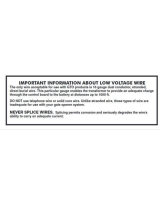
6
7. Route the Wire Rope Under the Bottom Bracket Pulley (Figure 1-7): Pass the Wire Rope through the drive-
side cable port, down and around the groove in the Bottom Bracket Pulley, and out the opposite cable port. Pull a
suffi cient length of Wire Rope through the Bottom Bracket to allow cutting and termination of the Wire Rope Loop.
8. Cut the Wire Rope to length (Figure 1-8): Pull on both ends of the Wire Rope to remove slack and ensure the
Wire Rope is properly seated in all Bracket Pulleys. Cut the excess off one end of the Wire Ropes so the two ends
mate up when pulled together to form a continuous loop.
IMPORTANT: When cutting the Wire
Rope, do not allow the ends to unravel or
bend out of place.
9. Splice the Wire Rope ends together to form a Continuous Loop: Splice the Wire Rope ends together with the
provided U-Loop Compression Splice. See “Installation Sheet 5903448” for details.
10. Adjust the Bottom Bracket and Top Bracket for proper Wire Rope alignment: Angle the Bottom Bracket and
Top Bracket so the Wire Rope Loop travels freely through all cable ports without rubbing the grommets inserted in
each port. The Wire Rope Loop should be approximately centered on the climbing side of the ladder.
WARNING: The Powered Climb Assist System should be positioned so it does not interfere with proper operation of the required
Fall Arrest System and impede the Fall Arrest System’s ability to arrest a fall.
11. Tighten all Rung Clamps: Once the Top Bracket and Bottom Bracket are properly positioned, tighten all Rung
Clamps equally. Torque each bolt to 10 ft-lbs (13.5 Nm), or tighten as far as possible without deforming the rungs.
12. Tension the Wire Rope Loop (Figure 1-12): The Drive Bracket Assembly has a Tension Gauge on the side of the
enclosure. Turn the Tensioning Bolt on the bottom of the enclosure until the Red Indication Tab is positioned in the
green zone on the Tension Gauge: Turn the Tensioning Bolt counterclockwise to increase tension. Turn the Tensioning
Bolt clockwise to decrease tension. Multiple turns may be required for visible movement of the Red Indication Tab.
NOTE: When tensioning a newly installed system, the Wire Rope will relax and stretch during the fi rst few seconds of climbing. To
avoid damaging the Drive Pulley, the system will likely require additional tensioning immediately after the fi rst bit of climbing.
13. Secure the Bracket Covers: Place the covers back on the Top Bracket, Bottom Bracket, and Drive Bracket
enclosures and tighten the cover screws.
WARNING: Exercise extreme caution to prevent dropping the Top Bracket cover during installation.
14. Install Wear Guards (Figure 1-14): Eight Wear Guard assemblies are included with the Powered Climb Assist
System (see Table 1). Mount Wear Guards on surfaces on which the Wire Rope might rub during operation of the
Powered Climb Assist System (e.g., ladder rungs, platform hatch doors, etc.). Mounting options are as follows:
• Mounting on Smooth Surfaces: Clean the mounting surface thoroughly. Peel the backing off the adhesive strip on
the back of the Wear Guard. Position the Wear Guard on the mounting surface and then press down fi rmly to adhere.
• Mounting on Rough or Uneven Surfaces: Position the Wear Guard on the mounting surface. Using the Wear
Guard as a template, drill two holes, approximately 1/2 in (12 mm) deep with the provided #19 Drill Bit. Thread
the holes with the included M5 x .8 Tap. Secure the Wear Pad to the mounting surface with two Hex Socket Flat
Head M5 Screws (also included).
NOTE: Ensure the Compression Splice does not make direct contact with sharp edges on a platform hatch door. Mount Wear
Guards at the bottom edge of the hatch door fl ange to prevent contact between the Compression Splice and edge (see Figure 1-14).
15. Secure the Power Cord: Multiple Power Cord options are available for the Portable Motor Control to accommodate
power source variations worldwide. Each installed Powered Climb Assist System should include an appropriate Power
Cord that remains with the system. Position the Power Cord so it can be readily plugged into the Motor Control Unit
and power receptacle and secure it in place with the included Cable Ties.
4.0 INSPECTION
4.1 INSPECTION FREQUENCY: The Powered Climb Assist System must be inspected at the intervals defi ned in Section 1.
Inspection procedures are described in the “Inspection and Maintenance Log” (Table 2).
4.2 DEFECTS: If inspection reveals an unsafe or defective condition, replace or repair the affected component(s) prior to
further use of the Powered Climb Assist System. Repairs must be performed by an Authorized Service Center. Contact
Capital Safety.
4.3 PRODUCT LIFE: The functional life of the Powered Climb Assist System is determined by work conditions and
maintenance. As long as the product passes inspection criteria, it may remain in service.
5.0 MAINTENANCE, SERVICING, STORAGE
NOTE: Only Capital Safety or parties authorized in writing may make repairs to this equipment.
5.1 CLEANING: If the Wire Rope Cable becomes soiled with oil, grease, paint, or other substances; clean the Wire Rope with
appropriate cleaning solutions. Do not use acids or caustic chemicals that could damage the cable.
5.2 AUTHORIZED SERVICE: Additional maintenance and servicing procedures must be completed by an Authorized
Service Center. Authorization must be in writing. Do not attempt to disassemble and repair components of the
Powered Climb Assist System.
5.3 STORAGE: When not in use with the Powered Climb Assist System, store Motor Control Units and Cable Grips in a
cool, dry, clean environment out of direct sunlight. Avoid areas where chemical vapors may exist. Thoroughly inspect
components after extended storage.














